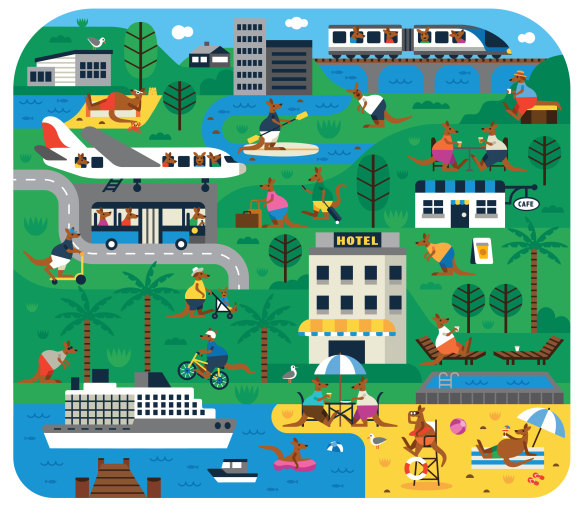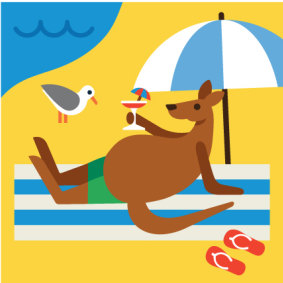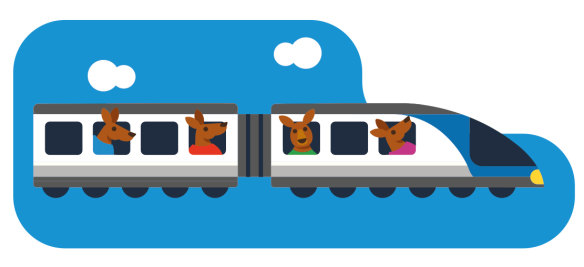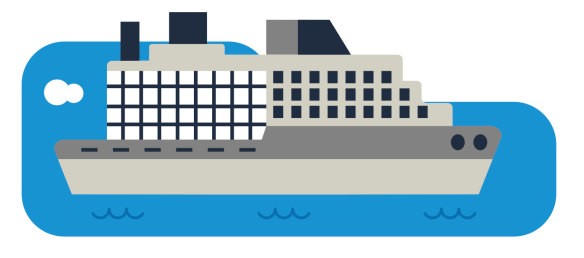This was published 2 years ago
Our experts’ 52 greatest money-saving travel tips
We don’t need to be reminded that times are tough and likely to get tougher. But tough times do not mean you should stop travelling.
You may be amazed at how much you’ll save by following commonsense or canny advice on how to best drive, cruise, train and fly your (fairly insipid) Australian dollar further both overseas and at home but especially overseas.

Illustration: Greg StraightCredit:
We’ve consulted Traveller’s experts – our leading globetrotting travel scribes who know a bargain or 10 – for their all-time best money-saving tips for Australian travellers.
The result? This exhaustive list, encompassing food and wine, transport and accommodation is all about how to economise shrewdly without sacrificing that crucial holiday enjoyment and fulfilment holiday factor. Who, after all, wants to come home richer but miserable?
FOOD + WINE

Illustration: Greg StraightCredit:
1. Let’s do lunch (and skip dinner) So you want good food – the best food – but don’t want to pay full price? Join the club. Lunchtime dining is your answer. In much of mainland Europe, look for restaurants doing “prix fixe”, or discounted set-menu lunches. In Japan, meanwhile, high-end restaurants offer discounted lunch seatings.
2. Convenience stores really can be convenient Not all convenience stores are created equal. However, if you’re in Japan or South Korea, these one-stop shops will be filled with affordable, tasty cuisine, everything from pasta dishes to dumplings to fried foods. And drinks such as coffee and beer are similarly cheap.
3. Thirsty? Try these tips for a tipple Don’t go out to bars if you’re really intent on saving money. In Europe, head directly to the supermarket, where beer and wine are very cheap. If you’re in a wine-producing region on the Continent, it’s often possible to find wineries that sell their product in bulk, in reusable containers.
4. Take it to the streets It may not be to everyone’s tastes, or for that matter, their constitutions, but if there is cheap food being served by street vendors in the place you happen to find yourself, you should be eating it. Whether they’re Thai noodle sizzlers or American burger flippers, this is often not just the most affordable but also the tastiest way to dine.
5. Become a member of the smorgasbord An oldie but, oh, what a goodie. If you’re staying in a hotel that offers a breakfast buffet, load up (within reason and with decorum, of course). Tuck a few croissants with some ham and cheese into your bag. Grab an apple. No need to let this stuff go to waste in this day and age, right.
6. Get fresh with the locals Local food cultures don’t begin and end in restaurants. For a more affordable experience, markets are ideal. At a typical market around the world you can pick up fresh, local and often artisanal produce at its cheapest, plus often feast on simple, light meals or snacks.
7. Eat what the locals eat Look around you. Locals aren’t eating in fine-dining restaurants every night. Quite often, you will discover, they’re eating in the most affordable and most enjoyable way possible. Maybe that’s home-cooking, maybe street food, maybe in hole-in-the-wall trattoria. Still, there’s much to be learned.
8. Happily exploit happy hours Pretty much around the world, you will find bars offering happy-hour specials for those willing to arrive early for a few drinks. Take advantage of that. It’s even more enticing in the likes of Italy, too, where “aperitivo” drinks are usually served with free snacks.
9. Deliver your own budget This goes for any part of your travel experience, though particularly for food, which can so easily get out of hand spending-wise: make a budget. Decide what you can afford to spend, and when you can afford to spend it, and stick to it.
10. Get it while it’s d’hote “Table d’hote” dining is a multi-course meal with two or three options for each course at a fixed price, common in France and in Italy at osterie, wine bars that serve simple meals. It’s a great way to eat well and to save.
TRANSPORT

Transport yourself to a cheaper holiday.Credit: Greg Straight
11. Embrace a hire purpose You can usually reserve a hire-car without paying an upfront fee. Book well in advance and if a competitor offers a better rate closer to your departure, grab it and cancel the original reservation.
12. Tackle collision waivers head on Full collision damage waiver for your hired vehicle is expensive if you accept the policy issued at the car-hire desk. However, specialist insurers, such as Rentalcover.com (rentalcover.com) offer comprehensive cover at a much lower price.
13. Make a (right) day of it Choose an off-peak day for your flights. International flights that depart on weekends tend to be more expensive. Many flight search engines such as Momondo (momondo.com.au) give you day-by-day prices.
14. Drop the “shop till you drop” mentality Avoid the temptations of shopping in airports during a layover. Airport shops are expensive real estate and, apart from liquor, their wares are not always a bargain. You can buy goods in Australia and save on the GST provided you take them out of the country, and that’s usually a cheaper option.
15. Train yourself to take public transport Using public transport isn’t just cheaper than taxis (or Uber) it also gives you a better sense of the city. In many cities, budget-friendly daily or weekly transport passes are the smart choice but do your research, as there are exceptions.
16. Think small not big Search out the lesser-known airlines for flights to and from Europe. Flying with Royal Brunei, for instance, adds one stop and 90 minutes to a trip to London, but can be as much $1,000 cheaper than the one-stop big names.
ACCOMMODATION
17. Home sweet (someone else’s) home House swapping is a brilliant way to make massive savings on accommodation, especially for a family holiday. Home Exchange (homeexchange.com) has more than 100,000 properties on their books, from villas on the French Riviera to condos in Aspen, and membership is cheap.
18. Adopt a package mentality Book a package holiday. Since they bulk-buy, travel operators that put holiday packages together get a discount rate on travel, accommodation and activities, and they pass those savings along to the consumer. Check reviews carefully, as a price too good to believe may deliver a disappointing experience.

Illustration: Greg StraightCredit:
19. Make remote resorts your last resort Tropical island resorts a long way from anywhere are relaxing and can do wonders for your love life, so they say, but there is often no possibility of dining out beyond the resort itself with food and drinks prices typically high.
20. Go flat out If you’re travelling with a family, or even an extended one, an apartment is a great money saver. You can prepare your own meals and a two-bedroom apartment usually costs far less than two hotel rooms.
21. Treat yourself, with conditions Travelling is meant to be fun, so you want to allow yourself a few treats, but choose wisely. If you love an opulent hotel room, by all means splurge on a five-star stay but even out the expense by choosing cheaper eating options. If you live to eat, on the other hand, balance out meals at top-tier restaurants with budget-friendly accommodation.
22. Make your own meal of it It doesn’t matter if you’re travelling in Europe, the US or even Australia, if you have a kitchen at your accommodation (a hostel or Airbnb, or serviced apartment) and can cook meals for yourself, you will save money. A huge amount. And if you’re buying the right ingredients from fresh food markets you can still have genuine experiences of local gastronomic culture.
23. Switch off the booking engines Don’t expect booking websites to be cheaper. Compare prices on the hotel’s own website, or call hotels directly and you might get a better rate – or instead, a better room or complimentary breakfast. This is especially true of local and boutique hotels; international chains tend to have less flexible pricing.
24. Make it “always on a Sunday” On average, Sunday is the cheapest night to stay at a hotel, followed by Tuesday. If you have to travel over a weekend, consider a hotel that targets business customers (you’ll be able to tell by the facilities and location) as these will be tempted with better rates than tourist hotels. For luxury hotels, rates within a week or two of arrival are substantially lower.
CRUISING

Illustration: Greg StraightCredit:
25. If school’s out, rule it out Clearly school-holiday itineraries are the most expensive on family-friendly ships. Avoid December-January in Australia and July-August in Europe if you can. Shoulder seasons have lower cruise and airfares and decent weather: May or September in Alaska, April-May or September-October in Europe.
26. Be a bargain-hunter Sign up for cruise line e-newsletters and check out newspaper advertisements to keep yourself up-to-date on the latest deals. Facebook and Twitter are other good sources of up-to-the-minute offers. Cruise lines put out specials, spot sales, and promotional fares to fill stateroom on sectors that aren’t selling well.
27. Book early, very early With cruise demand constantly growing, last-minute bargains are now rare. For steep discounts, book a year in advance and sometimes two, or as soon as itineraries are released, since they’re promoted with special offers. You might get between 25 and 50 per cent off, or bonuses such as complimentary flights.
28. Sweeten up to the cruising sweet stop As a rule of thumb, January-February and (if booking cruises departing from Australia) September are the sweet spots for finding the best deals. Cruise companies are striving to sell cruises for the forthcoming summer with various incentives and extra inclusions.
29. Position yourself on a repositioning cruise When ships move from one region to another with the season, such as Europe to the Caribbean or Australia to Asia, itineraries come at bargain prices. Caveat: there’ll be more days at sea and fewer port visits, but some passengers find the on-board life relaxing.
30. Make friends with the neighbours Most voyages out of Australia are operated by big ships with lots of capacity, which means consistently lower prices per day compared to other destinations. December-February also sees many ships offering New Zealand cruises. The polar opposite, literally, are super-expensive small-ship cruises to Antarctica and the Arctic.
31. Go older to be wiser When a cruise line launches a new ship to great fanfare, they often cannibalise their own business as cruisers, eager to experience the new, swish ships. The result? It’s harder to fill the older (and perhaps smaller) ship, even though there’s nothing wrong with it. Prices fall accordingly.
32. Don’t make a balcony scene Cruise balconies are greatly overrated if you consider how little time you spend on them. You’ll save a motza by going without, and even more with an inside (yes, that’d be windowless) cabin. If you’re sociable or active, is your cabin environment really crucial? Higher decks also cost more.
33. Take yourself to the river Generally speaking, river cruises are more genuinely inclusive than ocean cruises, and you won’t need to spend another cent unless you want to. There are no extra-cost specialty restaurants or meal-time drinks, and shore excursions are included, though there may be added-cost alternatives.
34. Make travel insurance your firm policy It will cost you now, but might save you later. On top of your regular travel insurance, you will need to take out additional cover for cruising, plus for high-risk activities or adventure sports if contemplating edgy shore excursions. Even a simple visit to the ship’s doctor can be expensive.
TOURS

Illustration: Greg StraightCredit:
35. Go pricey to save money If you want the best value out of a tour, or “escorted journeys” as operators prefer to call them, pick an expensive travel destination such as Scandinavia, Iceland, Switzerland, Japan or, yes, Australia. Tour companies are repeat customers, so they can shave costs off hotel rooms, transport and entrance fees for which, as an individual, you’ll be paying top rate.
36. Take a peek at off–peak Tour prices fluctuate and you may have no need to travel during peak season – which isn’t always the best time of year anyway. For example, Europe in July and August is hot and crowded, and the cost of flights and hotel rooms soars; early June or late September is usually delightful.
37. Go with the pros It’s a much more uncertain travel world than previously. While Shonky Brothers Tours will be cheap, it won’t provide a safety net if things don’t go to plan – and that will cost you, possibly hugely, in the long run. Best use an established tour operator or travel agent.
38. Stay safe and check the COVID-safe plan The pandemic is by no means over. Does the tour company take steps to minimise risk? What happens if you catch COVID, and at whose expense? Is there a refund policy if you test positive before departure? Anticipating trouble is the best way to save future costs.
39. Lock it in now, not later If you don’t think travel is about to get cheaper – and currently it isn’t – then seal the deal on your package now, especially if heading to countries with high inflation, which includes some of tourism’s big destinations such as the US, Italy, Turkey and Greece.
40. Make one the one If you book everything with one supplier you can benefit from a discount (though not always, so do your maths). Among things you can add on are airfares, airport transfers, and pre- and post-tour stays in key cities. You may also get a discount for back-to-back tours.
41. Go big on the small print It’s tempting to “save” money by booking the cheapest of seemingly similar tours but study the small print. You may end up paying extra for anything from meals to entrance fees. Be sure to tot up all potential expenses in order to properly compare.
42. Break out on your own Some companies offer optional half-day activities at add-on cost, which can be overpriced. Check how easy they may be to manage on your own, or find your own alternative. In big cities, you can easily access interesting things to do more cheaply.
43. Don’t be sparing with your spare time Ask your tour leader or hotel concierge for advice on getting about. They may well have tips on public transport, free attractions and cheerful local restaurants that you can visit in your spare time, something that’s become increasingly common on today’s more flexible tours.
44. Give the flick to the knick-knackery You’ll be surprised at how much you can unwittingly spend on impulsive buys and useless knick-knacks. Ask yourself if you really need another snowdome or that box of dodgy tourist chocolates, and whether your batik pants will still look quite as good back home.
45. Enter at your own risk If your tour guide or driver shepherds you into a particular shopping outlet, there’s a good chance they will receive a commission on anything you buy, and the price is inflated accordingly. Shop alone, be prepared to bargain where appropriate and you’ll usually pay less.
MISCELLANEOUS
46. Get full bottle on the H20 If you are travelling in the warmer months, carrying your own water with you is an easy way to reduce costs. Plenty of cities are encouraging the practice, with Venice, New York and London among the places that publish maps of drinking fountains where you can fill up for free.
47. Don’t fail to get a pass If you’re spending several days in a big city, check what attraction passes are available. Chances are you’ll save a bundle over the cost of paying the full ticket price for each individual attraction.
48. Trust the government (really) When you go online to apply for a visa many non-government websites offer to help but they charge a hefty fee and do nothing to speed up the process. Make sure you’re at the official visa application website, usually indicated by “gov” in the website’s address.
49. Don’t be dim with SIMs Global roaming with your usual telco is convenient but the cost per day adds up. Either install a local SIM card, replace it with an international prepaid SIM card from a provider such as Simcorner, or buy an eSIM to cover the country you’re visiting. Airalo works well.
50. Step this way Most cities have free walking tours, often guided by students who want to practise their English, and they’re often passionate and well-informed, especially on local culture. You need to tip but the outlay will be comparatively low.
51. Achieve chart success Download the maps you’ll expect you’ll need on a trip to your phone. That way you won’t need to use data when you’re overseas and/or struggle when you inevitably find yourself in a mobile blackspot.
52. Worship churches Christian denomination churches are virtually free museums and usually readily accessed. Particularly in southern Europe and South America they’re often packed with great art and architectural wonders that you would otherwise have to pay to see.
Send us your own money-saving travel tips to travellerletters@traveller.com.au or post your tips as a comment below. We’ll publish the best pieces of advice we receive in our weekly letters.
Sign up for the Traveller newsletter
The latest travel news, tips and inspiration delivered to your inbox. Sign up now.